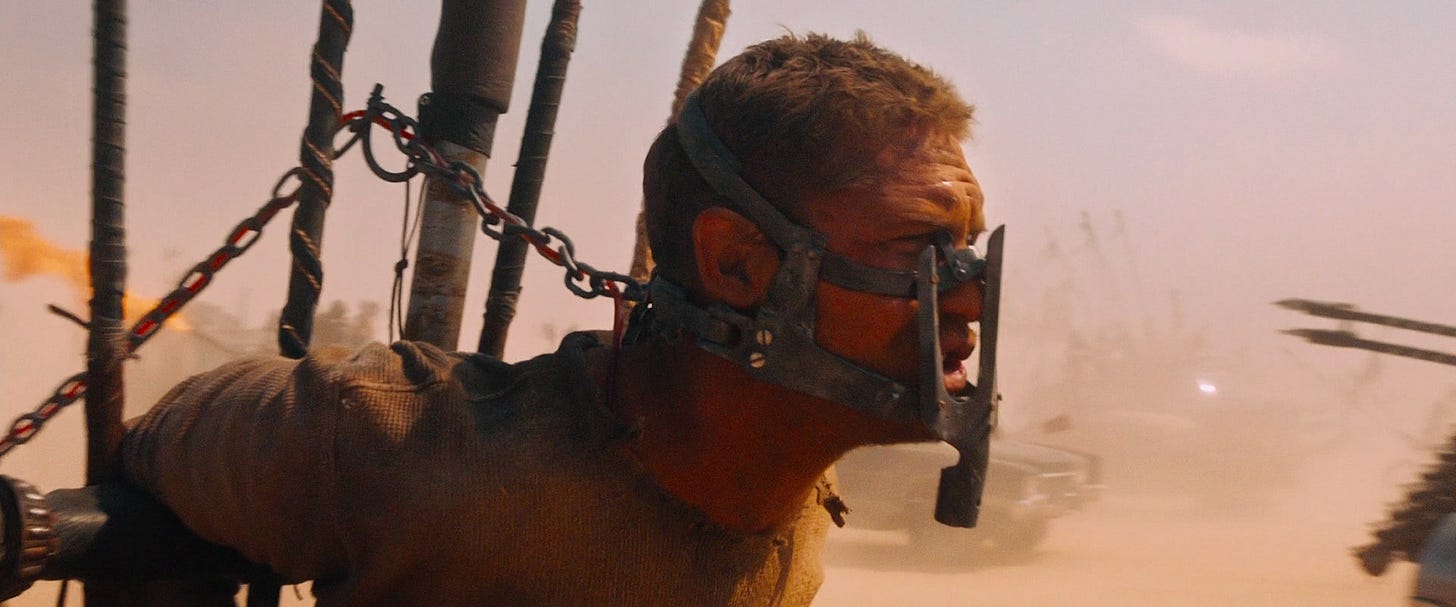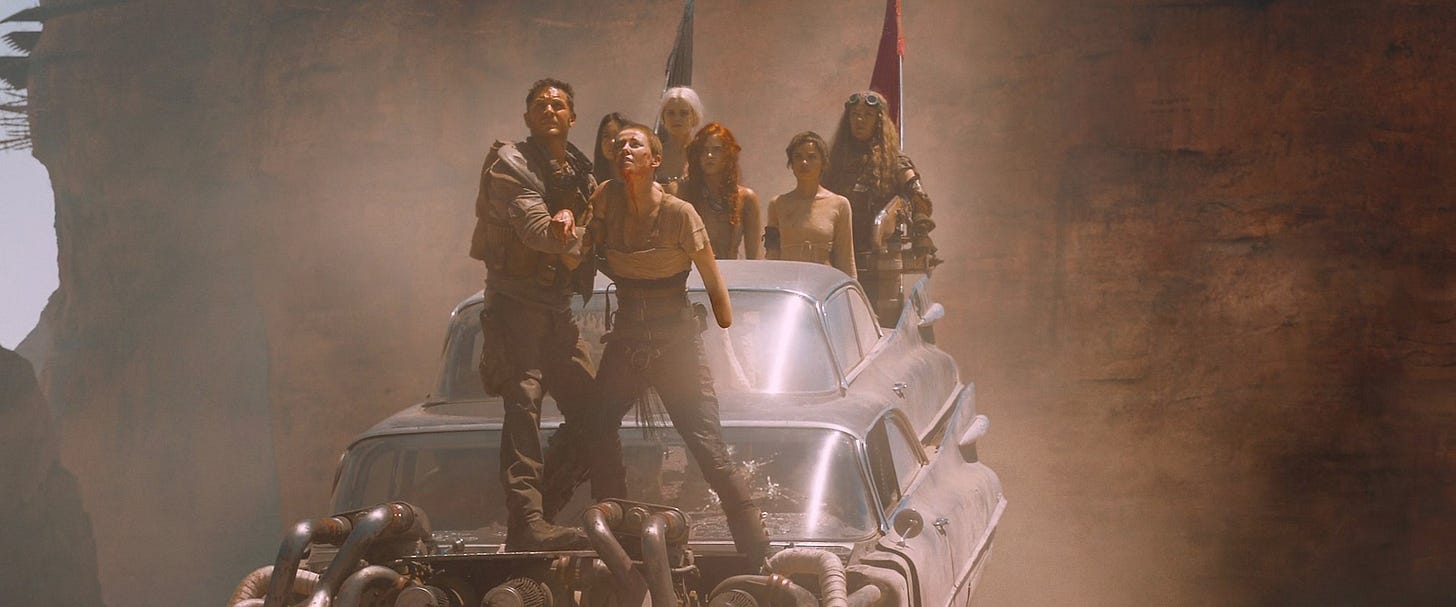Mad Max: Fury Road Structure Breakdown
As always, these breakdowns contain SPOILERS, and are only recommended if you've already seen the movie. You can check my introduction to these breakdowns, to get an overview of my process and philosophy.
Feel free to let me know what you think in the comments below!
The Basics
Director: George Miller
Writers: George Miller, Brendan McCarthy, Nick Lathouris
Release Date: 2015
Runtime: 120 Minutes
IMDB: https://www.imdb.com/title/tt1392190/?ref
Movie Level Goals
Protagonists: Furiosa
External: Get the wives to the Green Place
SUCCESS | FAILURE | MIXED
The Green Place is dead but Furiosa takes over The Citadel
Internal Goal: None
SUCCESS | FAILURE | MIXED
Protagonists: Max
External: Get the wives to the Green Place
SUCCESS | FAILURE | MIXED
The Green Place is dead but Furiosa takes over The Citadel
Internal Goal: Redeem himself for past failures
SUCCESS | FAILURE | MIXED
Two (Three) Observations
Feel free to watch the video or read the transcript below it.
Mad Max: Fury Road, directed by George Miller and written by George Miller, Brendan McCarthy, and Nick Lathouris, is considered one of the great action movies of the 21st century. Most people focus on the fantastic visuals and the non-stop action. Of course, there’s all kinds of behind-the-scenes drama that you can read about between Charlize Theron and Tom Hardy, as well as the trials and tribulations that went into the making of the movie. But for our purposes, I’m interested in the narrative structure and how the movie cleverly works with the concept of the protagonist to drive the plot, as well as how the final act works a little differently from typical final acts in movies.
Observation #1A:
Let’s start with our first observation, which actually includes two observations. I’ve broken this first point into two parts. It’s about the split protagonist in Mad Max: Fury Road.
When you watch the movie and ask, "Who is the protagonist?" you might feel a little stuck. Is Furiosa our protagonist, or is Max? After all, the movie has Max’s name in the title, and it starts with Max However, the movie really seems built around Furiosa, and of course, we now have a Furiosa sequel in the works. In some ways, she seems like the more important of the two characters.
But what I think George Miller and the other writers have done is really clever: they’ve split the role of the protagonist. They’ve taken the goals of both characters and intertwined them on one level, while also keeping them distinct in interesting ways.
Let’s look at Furiosa first. Furiosa’s external goal drives the movie and provides its structure. Her goal is to get to the Green Place with the women she’s rescued from Immortan Joe. Getting them to safety is her mission. Initially, it seems like she fails—at the end of Act Two, she discovers the Green Place is gone. Later, she decides to return to the Citadel to overthrow Immortan Joe. Furiosa provides the movie’s external goal, and in general, external goals provide the structure for films. In this sense, we could say Furiosa is the protagonist, or at least the protagonist who provides the plot’s structure.
However, if we look closer at Furiosa’s character, she doesn’t really have an internal goal. There’s nothing about her mentally, emotionally, or psychologically that she needs to change. She doesn’t have much internal conflict. She drives the plot and provides structure, but that’s where Max comes in.
Observation #1B:
Max gets paired up with Furiosa, and later, he shares some of her goals. He also eventually shares the movie’s larger goal of finding a safe place for the women. But what Max has that Furiosa lacks is an internal goal. Max seems to be looking for redemption. This gives him depth that Furiosa doesn’t quite have. Throughout the film, we see flashbacks—likely of a young girl who died, someone Max feels he failed to protect or save. He’s driven by a desire for redemption, to make up for this past failure.
Initially, Max is an enemy of Furiosa, just trying to get away from her. But as he spends more time with her and the women, and as we see more of his flashbacks, his internal goal of redemption pushes him to help Furiosa achieve her external goal. So, we have this interesting split protagonist: Furiosa provides the external goal, while Max embodies the internal goal.
This is really one observation about the split protagonist, but we can break it into two parts: Furiosa is the external protagonist, while Max is the internal one.
Observation #2:
The second observation I have is about the final act. Generally, when we get to a final act in a film, we find the characters at their lowest point, and we also find them confronting the antagonist more directly. Both of these are true in Fury Road. At the end of Act Two, the Green Place is gone, and there are hardly any survivors from Furiosa’s homeland. All the characters are at their lowest. At Max’s urging, instead of continuing into the desert to search for the ocean, they decide to return to the Citadel to confront Immortan Joe directly.
What’s unusual here is that the characters return to where they started. Max’s suggestion to go back means that they retrace their steps, revisiting the route they just traveled. This is rare in films and makes the final act of Mad Max: Fury Road unique.
It’s somewhat reminiscent of the first Alien movie, where Ripley sets the Nostromo’s self-destruct and then changes her mind, having to go back and try to deactivate it. She fails, of course, and ends up having to retrace her steps to the shuttle for escape. In Fury Road, the characters retrace their journey, but this time they aim to change the conditions of the place they started. In the climactic battle as they return to the Citadel, they defeat Immortan Joe. With no one left to rule, Furiosa takes over the Citadel, achieving her external goal of securing a safe place.
Max, meanwhile, succeeds in his internal goal of redemption. He’s helped others, cared for them, and led them to safety. At the movie’s end, he quietly slips away, as he’s always destined to be a loner, but both characters succeed in their respective goals.











